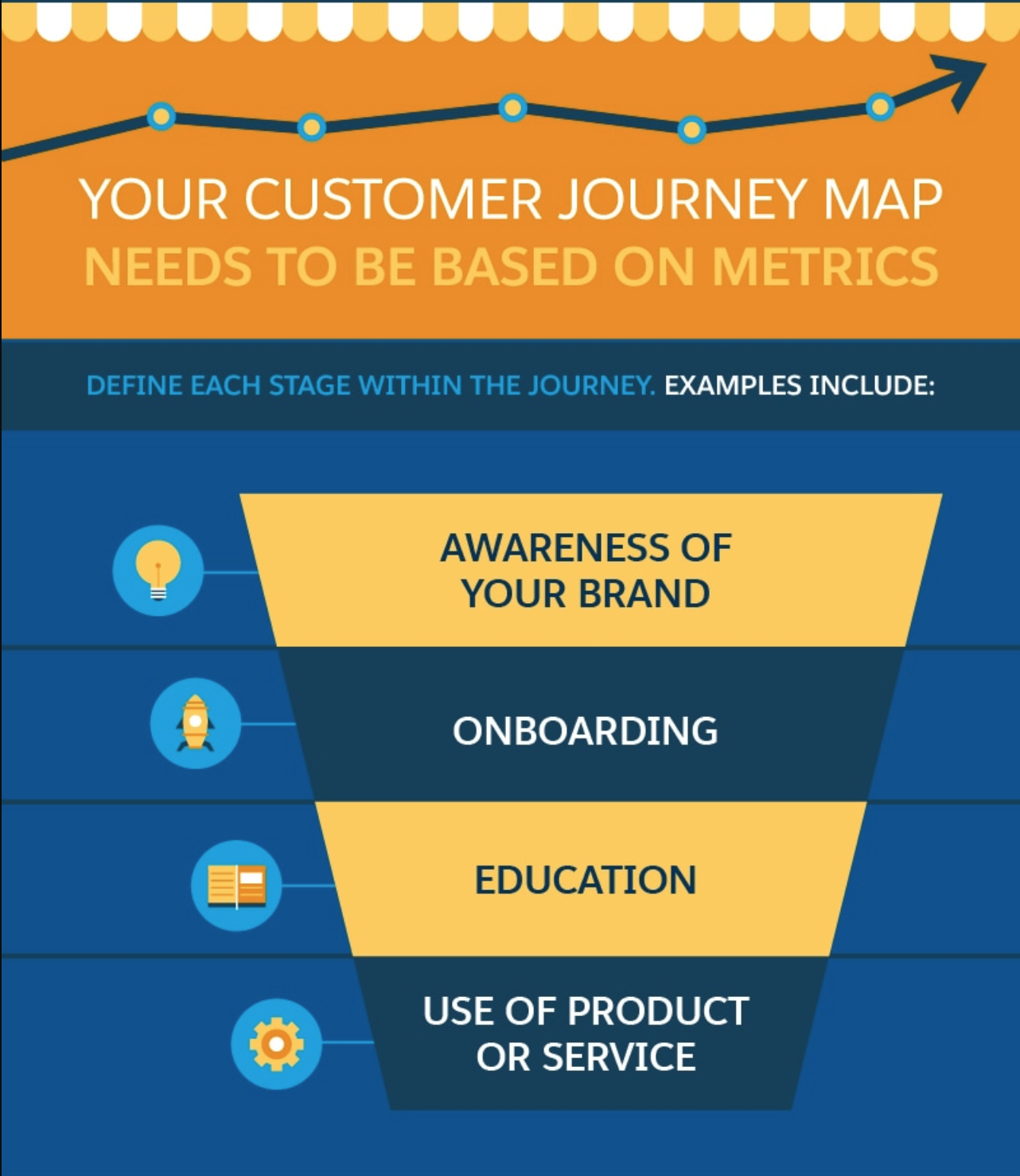Now more than ever, customers expect their experiences with businesses and brands to be as specialized and tailored to their needs as possible. Gone are the days when you could advertise and simply hope for the best. The digital age has created a savvier consumer with more sophisticated needs. His or her experience with your company is more complicated. It’s also easier these days for a competitor to slip in and offer the same services and products at the same price but with a better user experience.
As a digital marketer, it’s your job not just to sell your company’s services and products, but to ensure each customer’s experience is as positive as it can possibly be. One place to start is by creating a customer journey map.
What is a customer journey map?

Source: Mycustomer.com
If you’re not exactly sure what a customer journey map is, it’s pretty easy to figure out based on the name alone. Essentially, it’s a visual representation of every interaction a particular customer has with your business or brand, from the time they hear about it to the time they go onto your website or give you a call to the time they make a purchase and beyond. Obviously, no two customer journey maps are alike.
Creating a customer journey map gives you a glimpse at your business practices through the eyes of your customers. It helps you learn what makes your customers stick around and what makes them move on to shop from your competitors. The patterns you discover can help change the way you do business by eliminating those negative experiences that drive customers away. It will also help you fill in the gaps that stand between what you actually offer and what your customers have come to expect from a company in your position.
Where to start when creating a customer journey map?

While no two customer journey maps will be alike, you’ll need a starting point to create one. This is where your customer personas come into play. Of course, a customer or buyer persona is an image created, based on research, to reflect who your customers are. If you haven’t yet created one or more personas, it’s time to do that. If you have, choose one to use as the starting point for your journey map.
Touchpoints will also be an important part of your customer journey map. These are moments when a customer is interacting with your brand, whether they are clicking on your website, viewing an ad for your product, or actually purchasing one of your services. You’ll need to know the channels where these touchpoints occur, as well, whether it’s on their mobile device, in your store, or something else entirely. For example, if the touch point is “buy a product,” your customer may have the option to do that on your website, over the phone, or in person.
Other important parts of your customer journey map may include your timeline. That may be six months or it may be the time between when a customer visits your website and when he or she makes a purchase. Positive and negative reactions will also be a part of your map. Finally, you’ll want to take a look at your brand’s goals, as well as your customer’s goals. What do you each of you want to achieve during your interactions?
Gather and take a look at your research
Before you get started, you’ll also want to gather and review as much research as possible. The more you have, the more detailed you can make your map. The more detailed your map is, the more helpful it may be in determining how you can increase your sales. Depending on what works best for your niche, you can take advantage of customer interviews, social media listening and other social analytics, surveys from your website, call logs from your customer service lines, your website analytics, emails from customers, and anything else you can get your hands on.
Brainstorm and map your touchpoints and other interactions

Now, it’s time to get into those touchpoints. Based on your research, you should have an idea of what your big ones are, but are there any small ones you’re missing? Sit down and brainstorm (and keep in mind that the more people you brainstorm with, the more you’ll come up with). You’ll also want to make a list of potential touchpoints and related channels. For example, if your touchpoint is “follows your brand on social media,” and you have channels that include Facebook, Twitter, and Instagram, but you could add a YouTube channel in the future, you’ll want to include YouTube.
It may help your brainstorming to break the customer’s experience down into smaller categories, such as:
- Before the customer interacts with your brand: What brought them to your site? Was it a Google search? Word of mouth? Did they see an ad on Facebook?
- While the customer is checking out your brand: Are they on your website? Are they following you on social media? Are they visiting your store or asking their friends if they’ve ever used you?
- When the customer executes a purchase: Are they paying online? Do they have questions or complaints about the process? How long did they spend on your product pages?
- After the purchase: Will the customer return? Does he or she have a complaint? If he or she reviewing your brand on a site like Google or Yelp?
Keep in mind that Google Analytics, if you use it, will provide you with invaluable information when brainstorming and mapping your touchpoints and channels.
Put yourself in the customer’s shoes
Now it’s time for a little understanding of what your customers think and feel. With the information you already have, you can step back and try to understand whether or not they are reaching their goals. This is where you determine what works, and more importantly, what doesn’t. Are certain customers leaving your website once they reach a particular page? Perhaps they go to purchase a product but leave when they see how much information you require them to enter during the checkout process. Put your acting and empathy skills to good use and try to think like your customer. What about your brand or the buying process would turn you off from buying a product or service you need? Does your research or brainstorming lists support that?
You can even try interviewing yourself in the same way you might conduct a customer interview. Ask yourself questions like “How did you hear about us?” and “What did you like and dislike about our website?” Or “Do you wish X page on our website had more information about X product?”
Draw your map

Now it’s time to put everything you’ve discovered onto an actual map. How you do this is entirely up to you and your team. Some people like to sketch it out on a large whiteboard for the room to see, and some like to keep it simple with a pen and paper. You can do it on a computer so that it’s interactive. You can make it out like a timeline, or put it into a circle. Just make sure that your marketing team can access and understand it easily. You’ll also want to keep in mind that you’ll constantly want to refine your customer journey map so you may want to choose a template that is easily manipulated.
Customer Journey Map Templates
Here are some helpful, free customer journey maps from around the web:
(Note: For the Google docs & Google Sheets customer journey templates, click File > Make a copy)
- Google Sheets Template
- Google Docs Template
- PDF Template
- PowerPoint Template
- Customer Journey Map Example
You can also use the following software and use the supplied customer journey templates:









